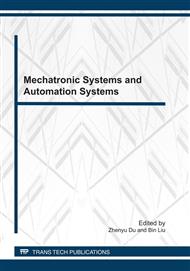[1]
D. Yi, V. Hayward. Skeletonization of Volumetric Angiograms for Display[J]. Computer Methods in Biomechanics & Biomedical Engineering, Vol. 5-5(2002), pp.329-341.
DOI: 10.1080/1025584021000003874
Google Scholar
[2]
H. Blum. A Transformation for Extraction New Descriptors of Shape. In: Models for the Perception of Speech and Visual Form. Cambridge, MA.: MIT Press. ( 1967. ).
Google Scholar
[3]
N. D. Cornea, M. Silver Dp. Curve-Skeleton Applications. in IEEE Visualization Conference. (2005).
Google Scholar
[4]
N. D. Cornea, P. Silver Dmin. Curve-skeleton properties, applications, and algorithms [J]. IEEE Transactions on Visualization and Computer Graphics, Vol. 13-3(2007), pp.530-548.
DOI: 10.1109/tvcg.2007.1002
Google Scholar
[5]
G. Z. A. Bertrand. A three-dimensional thinning algorithm using subfields. [J]. Vision Geometry III., 2356(1994), pp.113-124.
Google Scholar
[6]
A. Telea, A. Vilanova. A robust level-set algorithm for centerline extraction. In: Proceedings of the symposium on Data visualisation. Eurographics Association Aire-la-Ville, Switzerland, Switzerland. (2003).
Google Scholar
[7]
D. Ivanov, S. E. Kuzmin An efficient integer-based skeletonization algorithm[J]. Computersand Graphics, Vol. 24-1(2000), pp.41-51.
DOI: 10.1016/s0097-8493(99)00136-3
Google Scholar
[8]
W. J. Che, X. N. Yang and G. Z. Wang. A Dynamic Approach to Skeletonization. Journal of Software. Vol. 14-004(2003), pp.818-823.
Google Scholar
[9]
J. H. Chuang, K M. Tsaichc. Skeletonisation of three-dimensional object using generalized potential field [J]. IEEE Trans. Pattern Analysis and Machine Intelligence, Vol. 22-11(2000), pp.1241-1251.
DOI: 10.1109/34.888709
Google Scholar
[10]
F. C. Wu, W. C. Ma and C. Lioup. Skeleton Extraction of 3D Objects with Visible Repulsive Force. In: Eurographics Symp. On Geometry Processing. (2003).
Google Scholar
[11]
N. D. Cornea, D. Silver and X. Yuan. Computing hierarchical curve-skeletons of 3D objects [J]. The Visual Computer, Vol. 21-11(2005), pp.945-955.
DOI: 10.1007/s00371-005-0308-0
Google Scholar
[12]
P. Prez, M. Gangnet A. Poisson image editing [J]. ACM Transactions on Graphics (TOG), Vol. 22-3(2003), pp.313-318.
DOI: 10.1145/882262.882269
Google Scholar
[13]
L. Gorelick, M. Galun and E. Sharon. Shape Representation and Classification Using the Poisson Equation [J]. IEEE Transactions on Pattern Analysis and Machine Intelligence, Vol. 28-12 (2006), p.1991-(2005).
DOI: 10.1109/tpami.2006.253
Google Scholar
[14]
Information on http: /local. wasp. uwa. edu. au/~pbourke/geometry/spherepoints.
Google Scholar


